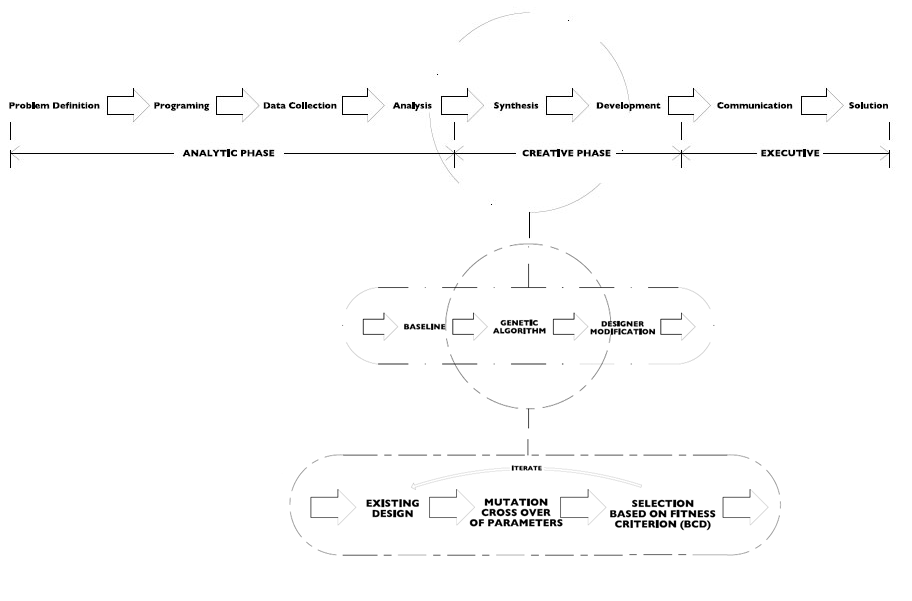The following chapter describes the general method and design process this research will be introducing which
combines a GA with FD to produce design variants that serve as the basis for a design charrette involving a designer
and juried critiques. I propose to develop and test BCD as an objective function within a GA-based design process
that considers and draws from the richness of precedent. I will be using a GA to experiment with generating designs
with a high degree of complexity as measured by the fractal dimension of their spatial configurations. Fractal
dimension is a standard method for assessing spatial complexity as discussed in the literature (Mitchell, 2009). BCD
has been shown to be an inexpensive analytic tool for analyzing architecture (Ostwald, 2013). As proof of concept, a
case study will be developed and presented and the results critiqued by a jury of experts. I will code and employ an
objective function that uses a quantitative approach (BCD) to analyze the fractality of design variants produced by a
GA. Initial baseline designs will be culled from the body of work and the design methodology of the late designer
and professor Dean Bryant Vollendorf (DBV) (See Appendix). Baseline designs will be modified by a GA and other
tools available out-of-the-box in commercially available software such as Galapagos for Rhino / Grasshopper. The
GA will be used to increase the fractal dimension of given designs by measuring each generation of design variants
with BCD with respect to rules established in the methodology and a pre-defined design problem (see section 3.1).
The results of this process at particular phases will be reviewed by a panel of experts in a series of juried critiques
culminating with a final presentation and critique. Jurors’ comments will be recorded and presented (see section 4.0).
During this process, the researcher will iteratively take the output from the GA, modify (tune to fit) the output
relative to the design problem and previous critique and present for jury review (pin up). This three-step cycle is
represented in Fig. 3.0.0 and will iterate multiple times.
Fig 3.0
MACRO PROCESS: The macro process represents the process or steps for the experiment to be conducted, which is
a sub-process of a larger design process. The design process as a whole is labeled the macro process (macro-level). I
use here Bruce Archer’s design process as a starting point because it relates well with the standard architectural
services defined by the American Institute of Architects (AIA) and is well known in design and creative professions
(Boyd, Gristwood, 2016). In figure 3.0.1, synthesis, development and communication correlate with the architect’s
services: schematic design, design development and working drawings.
FIG 3.0.1. Diagram of design process at macro level.
MEZZO PROCESS: The sub-process defined within the design process expands on the schematic design phase to
include an algorithmic design phase as well as a human design component. I label this sub-process the mezzo
process (Fig. 3.0.2). The mezzo process (mezzo-level) has a feedback loop which is an iterative critique at
milestones within the experiment where a jury of architects and other experts will respond to a selection of GA
outputs and designs and offer comments and criticisms based on their expertise. There will be a number of juried
critiques at various stages of the study working up to a final presentation and critique at the culmination of the study.
FIG 3.0.2. Diagram of design process at mezzo level

FIG 3.0.3. Diagram of design process at micro level.
MICRO PROCESS: The algorithmic design phase unpacks further as a micro process within the mezzo process (Fig.
3.0.3). The micro process (micro-level) has a feedback loop which is the iterative design generations within the GA.
The micro process consists of a number of designs which are initially culled from a collection of architectural work
(discussed in section 2.3). These designs represent the first generation of a genetic algorithm. The genetic algorithm
creates many design variants with slight mutations and from this landscape selects a number of variants with high
fitness. Fitness for this experiment is defined as high BCD. Fitness does not imply the variants are more fit designs,
only that they score higher in terms of BCD. From this second generation the process repeats for a certain number of
runs and then outputs one or more variants representing the highest local optima. These selected variants are then
used as the initial designs at the mezzo-level. The mezzo-level uses the output from the GA as the input for a
conventional design charrette where the researcher will modify designs to conform to the program and project
requirements. The back and forth between these two levels will occur until the process converges on an appropriate
design as decided by the jury.
This paragraph describes the objectives and evaluation for the meta-design process that will be done by the
dissertation committee after the case study is complete. The design process described in Figures 3.0.2 and 3.0.3 will
be developed and used for the case study described in sections 3.1–3.6. After the case study sub-project is complete the overall case study process or meta-process will be reviewed generally in terms of the efficacy of FD as an objective function for GA within a context of human-centric creative design and juried review. The objective for the
macro-process, which is the efficacy and potential scalability of the applied design process, will be assessed by the
dissertation committee after the case study is complete. Efficacy will be gauged qualitatively by the committee based
on the expertise and knowledge of members. Comments will be recorded and included in chapter 5.0.

